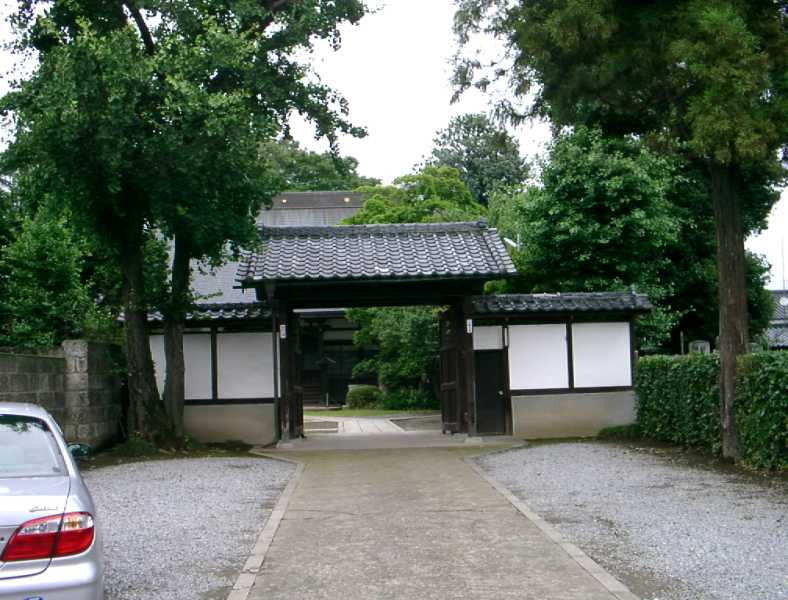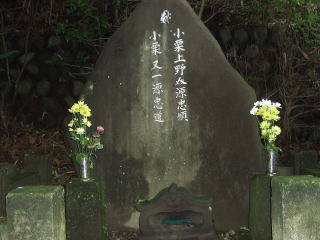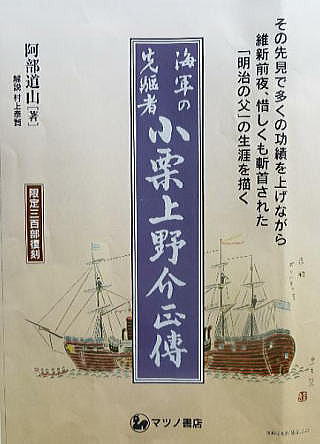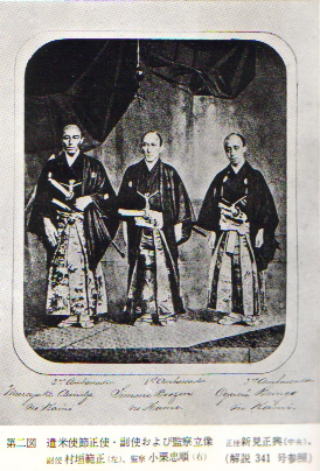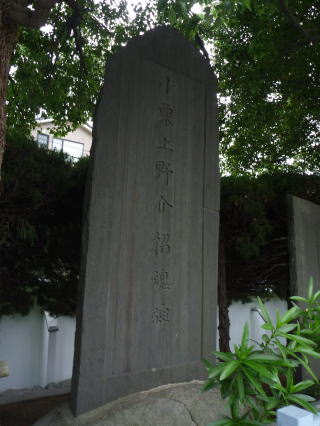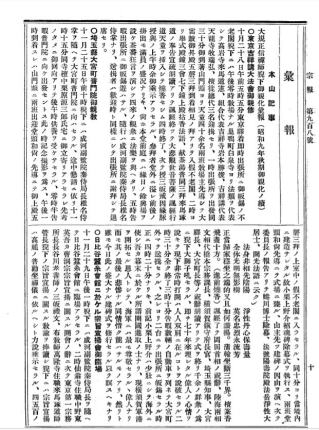●小栗上野介家の菩提寺
Family temple of the Kozukenosuke Oguri family
・文中約20ヶ所に「小栗家の菩提寺(あるいは菩提所)の普門院」 とある。
普門院には小栗家四代目小栗忠政の墓はあるが(*小栗上野介忠順は十二代目)、その他にたくさんある「小栗○○の墓」は忠政の二男で分家した小栗仁右衛門信由家の累代の墓である。
小栗家本家の菩提寺は、『寛政重修諸家譜』に五代目小栗政信以降について「保善寺を葬地とす」とある通り、明治初年までは曹洞宗保善寺(中野区・もと牛込にあった)である。
In about 20 places in the book, there are references to "Fumon-in is the family temple of the Oguri family."
In Fumon-in Temple, there is the grave of Tadamasa Oguri, the fourth generation of the Oguri family (*Kozukenosuke Tadamasa Oguri was the twelfth generation of the Oguri family. The kanji characters for "Tadamasa" are different between the fourth and twelfth generations). However, all the other "Tombs of Oguri XX" at Fumon-in Temple are the graves of the successive generations of the Niemon Nobuyoshi Oguri family, who was the second son of Tadamasa Oguri (the second generation) and was a collateral family.
The family temple of the Oguri family is Hozenji Temple (Nakano Ward, formerly
Ushigome Ward, Tokyo), a Soto sect temple, as stated in the "Kansei-Choshu-Shokafu"
as "Hozenji Temple is the place of burial" for Masanobu Oguri
(the fifth generation of the family) and later generations. (Note: "Kansei-Choshu-Shokafu"
is a collection of family histories of feudal lords and hatamoto compiled
by the Edo shogunate during the Kansei era.).
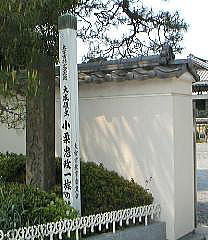
▲普門院門頭の「小栗忠政一族の墓」標柱
The Station Pole at the entrance of Fumon-in Temple: "Graves of Tadamasa
(the fourth generation) Oguri family"
明治以降小栗家本家は神葬祭に移ったので保善寺から離れ、雑司ヶ谷霊園に墓地を設けている。
江戸から遠い東善寺は五代目小栗政信を中興開基とするゆかりはあるが「小栗家の菩提寺」ではない。たまたま当地で斬首された小栗上野介主従を埋葬したので「小栗上野介父子主従の菩提寺」となった。
After the Meiji era (1868-1912), the head family of Oguri families adopted
Shinto funeral service, so they moved away from Hozenji Temple and established
a cemetery in Zoshigaya Cemetery.
Tozenji Temple, which is far from Edo, is not a "family temple of
the Oguri family," although it is associated with the fifth generation
Masanobu Oguri as the founder of the temple. It happened to be the family
temple of Kozukenosuke Oguri and his son, who were beheaded in this area
and buried at the temple.
●小栗家系図の省略
Partial Omission in the Oguri Family Tree
小栗上野介家家系図 P22
文中22ページには小栗上野介家の家系図として
初代松平太郎左衛門信吉
二代松平忠吉
三代小栗吉忠
四代小栗忠政 普門院ニ葬ル
…と四代目までが掲載されているが、保善寺に葬られた五代目小栗政信以降が記載されず省略されている。
阿部師はこの記述は「寛政重修諸家譜に依る」と書いているから、『寛政重修諸家譜』に
・五代目小栗政信以降について「保善寺(元牛込、いま中野区)ヲ葬地トス」
とあるのを承知の上で、記載を省略してしまったことになる。その理由は何か。
本書の文中随所約20ヶ所に「(普門院は)小栗家の菩提寺」と書き、それに対応してこのページの系図で四代忠政の説明に「普門院に葬る」と書いて五代目政信以降を省略すれば、ふつうの読者は『寛政重修諸家譜』で確認などしないから、五代目以降もとうぜん普門院に葬られているものと錯覚する。史料の恣意的選択によって「普門院は小栗上野介家の菩提寺」と錯覚されることを意図した省略と見られても仕方あるまい、と古老はいう。
On page 22 of the book, the family tree of the Kozukenosuke Oguri family
is shown up to the following four generations:
1st generation - Tarozaemon Nobuyoshi Matsudaira
2nd generation - Tadayoshi Matsudaira
3rd generation - Yoshitada Oguri
4th generation - Tadamasa Oguri ... buried in Fumon-in temple
However, 5th generation Masanobu Oguri, who was buried at Hozenji Temple,
and subsequent generations are not listed. Dozan Abe wrote that this description
was based on "Kansei-Choshu-Shokafu." If that is the case, it
means that he was aware that the "Kansei-Choshu-Shokafu" mentions
"Hozenji Temple (formerly in Ushigome Ward, now in Nakano Ward) as
the place of burial" for Masanobu Oguri 5th generation and later generations,
but he omitted this information in this book. What is the reason for this
omission?
"Fumon-in is the family temple of the Oguri family" is written
in about 20 places throughout the book, and in the genealogy on this page,
"buried in Fumon-in" is written in the explanation of Tadamasa
IV, omitting Masanobu Oguri 5th generation and after, which gives an illusion
that the fifth generation and after were buried in Fumon-in, since general
readers would not check in "Kansei-Choshu-Shokafu." It may be
seen as an omission intended to create the illusion that "Fumon-in
is the family temple of the Kozukenosuke Oguri family" through arbitrary
selection of historical documents.
●小栗上野介父子首級の埋葬場所、はじめは館林だった
Burial place of Kozukenosuke Oguri's head was in Tatebayashi at first.
・「小栗上野介の首級は家来武笠銀介が水沼河原にさらされていた首級を盗んで普門院に運び、墓地に埋葬した」P6、162、185、360、363
としているが、ところが史実は次の通り。
武笠銀介は養子小栗又一忠道に従って高崎へ行き、閏四月六日小栗忠順主従が斬首された翌七日に城内で家臣3名とともに武笠銀介も斬首されるところを、若年(16歳)をもって、小者役で随従した権田村農民3名とともに赦免され、そのまま江戸の父武笠祐左衛門に小栗父子主従の急を知らせている。もし普門院説のように武笠銀介が赦された7日に高崎から1日かけて水沼河原へ戻ったとしても、首級は斬首した六日に高崎藩が高崎城内へ運んだ後だから、翌日に斬首を免れたばかりの銀介が介入できる余地はない。
検証 1 『太政官日誌』
1937昭和12年、館林の福田啓介図書館長が明治新政府軍の公式記録『太政官日誌』に「高崎藩からの届書」…「小栗父子の首級は首実検のため東山道軍総督府(館林に移っていた)へ送りました」・・・という記載を発見し、普門院説はこの記述で破綻、完全に否定される。
Verification 1: “Dajokan Nisshi (Diary of the Grand Council of State)"
In 1937 (Showa 12), Keisuke Fukuda, the director of the library in Tatebayashi, discovered an entry in the "Dajokan Nisshi (Diary of the Grand Council of State)" that states, "The heads of the Kozukenosuke Oguri and his son were sent to the Governor-General (Tatebayashi) for examination," which completely disproved the Fumon-in theory.
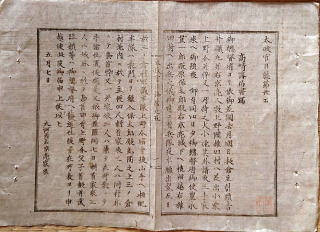
▲『太政官日誌』…「…上野介父子首級并武器類ハ総督府へ護送仕候…」 このころ東山道鎮撫総督府は館林に移っていた。
(HP「太政官日誌」慶応4年25号フルテキスト)
Dajokan Nisshi (Diary of the Grand Council of State): "The heads of
Kozukenosuke and his son and their weapons are to be escorted to the Governor-General's
Office."
The Governor-General's Office of the Tosando Province had been moved to
Tatebayashi at this time.
("Dajokan Nisshi," Keio 4, No. 25, full text)
検証 2 高崎藩士『島田弥七郎日記』 ・中村茂氏(高崎市史編纂専門委員)提供2023令和5年9月
◆高崎藩士「島田弥七郎日記」には小栗父子の首級について次のように記載されている。
「閏四月 十二日 己未 晴ル
一 上野介倅又一 右首級并武器等三藩之御人数為警固 総督御本陣館林迄罷越 引渡相済罷帰候旨 御徒士小頭兼太郎并一之助・栄七・斧太郎届出候事」
意訳(閏四月十二日 晴れ 小栗上野介と倅又一の首級及び武器などを三藩(高崎・安中・吉井藩)の軍勢が警護して東山道総督府が置かれている館林まで出かけ、引き渡しを済ませて戻った旨御徒士小頭の兼太郎并一之助・栄七・斧太郎から届け出があった)(小栗上野介顕彰会機関誌「たつなみ」49号 参照)
Verification 2: The Diary of Yashichiro Shimada, a feudal retainer of Takasaki Domain - Provided by Shigeru Nakamura (Special Advisor for Takasaki City History Compilation), September 2023
◆The diary of Yashichiro Shimada, a feudal retainer of Takasaki Domain, records the following regarding the severed heads of Kozukenosuke Oguri and his son:
April 12th, intercalary month (of the lunar calendar), sunny. A report was received from the squad leaders Kanetaro, Ichinosuke, Eishichi, and Onotaro, stating that the severed heads of Kozukenosuke Oguri and his son Mataichi, along with their weapons, had been escorted by troops from the three domains (Takasaki, Annaka, and Yoshii) to Tatebayashi, the location of the Governor-General's Office of the Tosando Region, where they were handed over, and that the escorting troops had now returned (to their domains).
●普門院の「首塚」について
Kubizuka at Fumon-in Temple
(Note*: A kubizuka is a mound where the heads of those killed in battle, those taken captive, or those beheaded are laid to rest.)
現在も普門院にある首塚は阿部道山師の勧めで小栗貞雄(遺児小栗国子の婿・作家矢野龍渓の弟)が1934昭和9年に建立したものである。小栗家に婿入した貞雄は権田村へ行ったこともなく、詳しい事情を理解しないまま勧められて「首塚を寄進」したのであろう。
その前年、徳富蘇峰は昭和8年に普門院を訪問し(昭和8年5月10日、東京日々新聞夕刊 by石原戒造 『小栗上野介を偲ぶ』マネジメント社昭和9年刊)
「・・・上野介の首を埋めたる土饅頭に向って一辯の香を捧げた」
しかし、専修大学白柳夏男教授は「小栗上野介遺聞」(専修大学論集第43号1987)で、
「1934昭和9年以前は土饅頭であり(P358)、その土饅頭も昭和7年5月以降~8年5月までの間に造られ、それ以前は何もなかった」
ことを検証している。
The kubizuka still standing at Fumon-in Temple was erected in 1934 (Showa 9) by Sadao Oguri (son-in-law of the deceased Kuniko Oguri and brother of the writer Ryukei Yano) at the recommendation of Master Dosan Abe. Sadao, who was groomed by the Oguri family, had never been to Gonda Village, and probably "donated" the head mound at the recommendation of the Oguri family without understanding the detailed circumstances.
The year before in 1933, Soho Tokutomi visited Fumon-in. He offered a single oratory of incense to the grave mound in which Kozukenosuke's head was buried. (May 10, 1933, Tokyo Nichinichi Shimbun evening edition by Kaizo Ishihara, "In Memory of Kozukenosuke Oguri," Management-sha’s 1934 edition).
However, Professor Natsuo Shirayanagi of Senshu University wrote in "Kozukenosuke Oguri Ibun (Untold Stories about Kozukenosuke Oguri)" (Senshu University Articles No.43 1987) verified that "before 1934 (Showa 9), it was a small grave mound (P358), and the mound was made between May 1932 and May 1933, and before that, there was nothing."
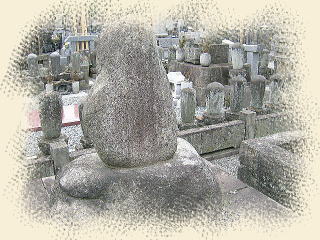
▲首塚と称する石(普門院境内)
A stone called "Kubizuka" (in the precincts of
Fumon-in Temple)
館林から小栗父子の首級を盗掘奪取した権田の村人は明治政府の管理下にあるものを盗んだのだから、「戻りさえすればいい」と口外せず、子から孫にのみ言い伝えて供養を続けてきた。(以下は繰り返しになるが、村人たちの上野介に対する思いが現れた部分だ。)
私(住職村上泰賢)が子どもの頃毎年4月6日に「お殿様のご命日だからこれをお供えしてほしい」と塚越太源治(小栗主従の墓石を造った塚越源忠の孫・源忠は会津から戻った後身体不調で館林の盗掘に同行できなかった人物)が重箱にお赤飯を詰めてお参りにきた。
その太源治は、昭和30年代後半になって、「祖父や親から堅く口止めされていたけれど、もう大丈夫でしょうから…」と、盗んだ首を源忠が中島三左衛門・塚越房吉(妹が源忠の妻)とともに東善寺の小栗上野介の墓に戻した時、
「胴塚(忠順の胴体を埋めた墓)を掘るとそれまでつけてあった木の首が傾いて肩のところにあった。それを取り出して本当の首を継ぎ、ご無念でございましょうがこれでひとまず安らかにお眠り下さい、と泣いた」
「確かにお首級(くび)はお寺にある」
と、房吉が語った話を前住職村上照賢に打ち明けた。
先師照賢は他の村人からの話でお首級を奪ってきて胴体と共にしたことは承知していたが、太源治が帰ったあとで「太源治さんは全く(人柄の)固い人だ」と、直接関わった者の子孫が戦後も20年近く経過してようやく重い口を開いたことにつくづく感じ入っていた。
村人はそれほど強く明治以来官憲による小栗上野介の業績抹殺圧力を感じていた、ともいえる。
The villagers of Gonda, who stole the heads of Kozukenosuke Oguri and his
son from Tatebayashi, have continued to make offerings, telling their children
and grandchildren only that "as long as the heads are with the bodies,
it is all right" since they had stolen something under the control
of the Meiji government. (The following, I repeat, is the part where the
villagers' feelings toward Kozukenosuke appear.)
When I (Taiken Murakami) was a child, every year on April 6, Tagenji Tsukagoshi came to Tozenji Temple with a stacked box filled with festive red rice, saying, "This is the anniversary of the Lord's death, so please offer this to the Lord Oguri." Tagenji is a grandson of Genchu Tsukagoshi, who built the tombstones of Kozukenosuke Oguri and his retainers, and who was unable to participate in the "Welcoming Lord's Head" robbery in Tatebayashi due to physical problems after returning from Aizu.
In the late 1950s, Tagenji confided one secret story to Shoken Murakami,
the chief priest at the time, saying, "My grandfather and parents
were very strict about not telling others about it, but I think it's safe
now. According to Tagenji, Genchu Tsukagoshi later told the following story
about the time when he, Sanzaemon Nakajima and Fusakichi Tsukagoshi buried
the stolen head in Oguri's grave at Tozenji Temple. "When we dug up
the body mound, we found the wooden head that had been attached to the
body tilted up to the shoulder. I took it out and put the real head on,
and cried out, 'I am sorry for your loss, but I hope you can rest in peace
now.'"
Shoken Murakami, the former chief priest of Tozenji Temple, had heard from
other villagers that the head had been taken from the temple in Tatebayashi
and placed with the body in the grave at Tozenji. However, he was deeply
impressed that the descendants of those directly involved had finally opened
their mouths after nearly 20 years had passed since WWII, saying, "Tagenji
is a very solid person."
It could be said that the villagers had felt such a strong pressure from
the government to erase Kozukenosuke Oguri's achievements since the Meiji
era.
・「高崎には豊国氏と云ふりっぱな郷土史家がをられ二十数年来偉人小栗上野介の顕彰に尽力してをられる。群馬の人々はかうした篤志家に依って、上野介にとって忘れ難き怨讐の地で遺徳顕揚に努めつつあるは感謝に堪えない」p188
阿部師が「感謝に堪えない」とほめた豊國氏は、戦前の群馬県における貴重な郷土誌『上毛及上毛人』の編集発行人豊國覚堂(とよくにがくどう・大胡町長善寺住職)のことで、上記引用文のように阿部師に小栗上野介研究・顕彰の努力を称賛されている。
"In Takasaki, there is a prominent local historian, Mr. Toyokuni,
who has been making efforts for more than 20 years to promote the memory
of the great Kozukenosuke Oguri. The people of Gunma are grateful for the
efforts made by such a devoted person to promote the legacy of Kozukenosuke
in the land of his unforgettable vengeance." (Page 188)
The man Toyokuni whom Abe praises is Gakudo Toyokuni (chief priest of Chozenji
Temple in Ohgo Town), editor and publisher of "Jomo and Jomojin,"
a valuable local magazine in Gunma Prefecture before World War II. Toyokunki
was praised by Abe for his efforts in researching Kozukenosuke Oguri.
ところが、褒められた豊國師は逆に普門院説によって岡田啓介首相が普門院に参拝したことに疑問を呈し(『上毛及び上毛人』220号・1935昭和10年)、さらに1937昭和12年、「小栗父子の首級を館林へ送った」という『太政官日誌』の記述を福田啓介
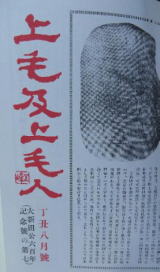
▲「上毛及び上毛人」1937昭和12年8月号
館林図書館長が発見したことを紹介し、
「之が為例のインチキ者流の化けの皮が忽ち剥ぎ取らるるは痛快の至りと謂ふの外なし」(「小栗上野介の首級問題」『上毛及び上毛人』244号・昭和12年8月)。
と、首級の普門院埋葬説を「インチキ」と一蹴している。
However, Toyokuni, who was praised, conversely questioned the fact that
Prime Minister Keisuke Okada, who believed in the Fumon-in theory, had visited Fumon-in (Jomo and Jomojin, No. 220, 1935 Showa 10). In 1937, Toyokuni introduced the discovery by Tatebayashi Library Director Keisuke Fukuda of an entry in the Dajokan Nisshi that "the heads of Kozukenosuke Oguri and his son were sent to Tatebayashi," and stated, "It is nothing short of a joy to see the phony
style of the past suddenly unmasked (Jomo and Jomojin, No. 244, August 1937), dismissing the theory that the head of Kozukenosuke
Oguri was buried in Fumon-in as "bogus."
●采地について
Fiefdoms of the Kozukenosuke Oguri Family
本書では小栗上野介家の采地は
・「武州大成村(普門院所在地)、上野邑おうら、多胡たごの三個所・・・」P1
としているがすべて誤り。
小栗上野介のころの主な知行地は次の通り
上総国武射郡稲葉村(千葉県芝山町) 152石
下総国香取郡五反田村(多古町) 117石
同 堀内村、大川村、田部村(香取市ほか) 156石
下野国高橋村、大沼田村(栃木県佐野市) 1354石
上野国群馬郡権田村(高崎市) 375石
同 下斉田村(高崎市) 170石
同 与六分(よろくぶ)村(玉村町) 88石
遣米使節から帰国後の加増地として
同 多野郡森村(藤岡市) 56石
同 小林村(藤岡市) 100石
その他細かいところもあって合計2700石で幕末を迎えている。
*普門院所在地の武州大成村は入っていない。
In the book, the following is written as the fiefdoms of the Kozukenosuke
Oguri family, but it is all incorrect:
"Ohnari Village in Bushu (where Fumon-in is located), Ohra in Kozuke
Province (today's Gunma Prefecture), and Tago in Kozuke Province..." (page 1)
The main fiefdoms of the Oguri Family while Kozukenosuke was the family
head were as follows:
Inaba Village, Musa County, Kazusa Province (today's Shibayama Town, Chiba
Prefecture): 152 koku
Gotanda Village, Katori County, Shimousa Province (today's Tako Town, Chiba
Prefecture): 117 koku
Horiuchi, Okawa, and Tabe villages, Katori County, Shimousa Province (today's
Katori City, Chiba Prefecture, etc.): 156 koku
Takahashi and Onumada villages in Shimotsuke Province (today's Sano City, Tochigi Prefecture): 1,354 koku
Gonda Village, Gunma County, Kozuke Province (today's part of Takasaki
City, Gunma Prefecture): 375 koku
Shimosaida Village, Gunma County, Kozuke Province (today's part of Takasaki
City, Gunma Prefecturey): 170 koku
Yorokubu Village, Gunma County, Kozuke Province today's (today's Tamamura
Town, Gunma Prefecture): 88 koku
After returning from the Japanese mission to the U.S., the following villages
were added:
Mori Village, Tano County, Kozuke Province (today's Fujioka City, Gunma
Prefecture): 56 koku
Kobayashi Village, Tano County, Kozuke Province (today's Fujioka City,
Gunma Prefecture): 100 koku
There were some other minor locations, totaling 2,700 koku at the end of the Tokugawa shogunate.
(Note: Ohnari Village in Bushu, where Fumon-in is located, is not included.)
●小栗上野介を斬首した人物
The man who beheaded Kozukenosuke Oguri
・「これで小栗を斬ったのですか、と私は問ふた。(原)はうむと、一言云ったきりだ…」 P171
小栗上野介を斬った人物は従来原保太郎と言われていた(蜷川新『維新前後の政争と小栗上野介の死』)が、それは正確ではなく、東山道軍軍監として全体を指揮している者が直接首斬り役をすることはあり得ない。小栗研究家小板橋良平『小栗上野介一族の悲劇』によれば安中藩の徒(かち)目付浅田五郎作が命じられて斬ったというのが真相という。
"I asked him if he had beheaded Oguri. Hara onloy groaned "Hmmm.'"
(Page 171)
The person who killed Kozukenosuke Oguri was traditionally said to be Yasutaro
Hara (Refer to “Political Strife Before and After the Restoration and the
Death of Kozukenosuke Oguri” by Arata Ninagawa). However, this does not
sound correct because there is no possibility that a person in overall
command as military commander of the Tosando Army directly acts as a beheader.
According to "Tragedy of the Kozukenosuke Oguri Clan" by Ryohei
Koitabash, Oguri researcher, the truth is that Gorosaku Asada, a kachimetsuke*
of the Annaka Clan, was ordered to do the beheading.
(Note*: Kachimetsuke is a position in the Edo shogunate. Under the direction
of the metsuke, the post was in charge of keeping watch in the Edo Castle,
supervising the arrival of feudal lords at the castle, and scouting for
the offices of various officials of the shogunate.)
●「村民が盗賊化」について
About "Villagers turned into bandits..."
・「小栗上野介が……権田に退耕中、村民が盗賊化し襲撃した……」P50
・「権田の村民が上野介を囲み掠奪したとあるが……」 P173
幕末維新期の無政府状態に乗じて博徒らの扇動で「ぶち壊し騒動」と呼ばれる暴動一揆が発生し、「借金を棒引きにする」「世直し」を唱えて、秩父方面から上州へ入ってきた。小栗一家が隠棲帰農をはかって江戸から1868慶応四年三月一日権田村東善寺に到着すると、後を追うように二日には4キロ下流の隣村三ノ倉村に入った。
小栗の家臣が出かけて交渉したが多額の金品を要求するため交渉は決裂し、四日に近隣の村々を威嚇扇動して、およそ2000人が権田村を襲撃した。小栗忠順は家臣と権田村農民を指揮してこれを撃退している(『小栗日記』群馬県史料集)。暴徒化したのは権田村民ではない。権田村ではむしろ襲われて火をかけられた家が11戸もあった。襲ったのは博徒らに威迫扇動された近隣村民であった。
史料によると
「・・・。慶応四辰年三月四日朝、賊徒博徒を頭取に、隣村々の百姓加勢して、権田村八方を取囲み、八方より攻め寄せ、鉄砲竹槍大刀鎗棒皆夫々の道具を携、時の声を上げて攻寄せ、百姓與右衛門浅五郎治平忠兵衛源七市助八兵衛甚右衛門徳右衛門徳兵衛善四郎の十一戸外に、堂二棟に火を掛け、焼払ふに依り、小栗殿主従も拠よんどころなく、鉄砲抜刀を持て、八方追払に掛る、凡そ六千餘人の徒党直に逃去り、一陣地宮原源兵衛宅本陣故、是を焼払、宮原は大集合地故、五軒皆焼払、追散、手向者源兵衛、市右衛門首打取、其外六人切捨、引続て川浦村岩氷村水沼村三ノ倉村へ使者を以て尋問す、今日の仕業、何の意趣遺恨有哉否哉、速に答辯為すべき旨を談示する所、各村一同、無法の申訳なく、詫を来たし依って和解となるなり・・・」(「権田村の長老某氏の保有する古文書」・蜷川新『維新前後の政争と小栗上野の死』日本書院昭和三年 p104)
上記を大まかに要点を意訳しておくと、
「…賊徒博徒を頭にして隣の村々の百姓が加勢し、権田村を八方から取り囲んで鉄砲・竹槍・刀・鎗などを武器にして攻めかけ、権田村の農家11軒とお堂2軒に放火した。小栗主従もやむなく鉄砲や刀で追払いにかかった。六千人ほどの徒党はすぐに逃げ去り、(東善寺の川向うの)宮原の源兵衛宅が本陣になっていたので、これを焼払い、さらに宮原は大勢が集合した場所だったから、5軒を焼き払った。手向った源兵衛・市右衛門の首を打取り、其他6人を切り捨てた。・・・」(意訳:村上泰賢)
昭和12年に類焼火災で焼失したが「焼ける前の本堂の正面の柱には、烏川の対岸から撃たれた鉄砲玉の跡がいくつもあった…」と土地の古老が言い伝えていた。
「権田の村民が盗賊化」は 『小栗上野介正傳』という書名にふさわしくない、重大な錯誤といえよう。そして以下の記述はこの錯誤を基に展開されていると考えられる。
"While Kozukenosuke Oguri was retreating to Gonda, the villagers turned
into bandits and attacked him. ......" (Page 50)
"Gonda villagers surrounded Kozukenosuke and plundered him. ......" (Page 173)
Taking advantage of the state of anarchy at the end of the Edo period and
during the Meiji Restoration, a riotous revolt called the "Buchikowashi
Riots" broke out at the instigation of gamblers, who entered Jyoshu
from the Chichibu area (today's part of Saitama Prefecture), chanting "get
out of debt" and "reform the world." The Oguri family arrived
at Tozenji Temple in Gonda Village on March 24, 1868 (March 1, Keio 4),
and the rioters followed them to the neighboring village of Sannokura,
4 km downstream along the Karasugawa River, the next day.
Oguri's vassals went out to negotiate, but negotiations broke down as they
demanded a large amount of money and goods. Two days later on March 27
(March 4th, Keio 4) about 2,000 people stormed Gonda village, threatening
and inciting neighboring villages. Kozukenosuke Tadamasa Oguri commanded
his vassals and the farmers of Gonda Village to repel the attack (Oguri
Diary, Gunma Prefectural Archives). It was not the Gonda villagers who
turned into a mob. Rather, some houses in Gonda Village were attacked by
rioters and set on fire. The rioters who attacked Gonda Village were neighboring
villagers who were intimidated and incited by the gamblers.
According to historical records:
"...On the morning of March 4th, the 4th year of Keio (1868), bandits and gamblers, led by their ringleaders, joined by peasants from neighboring villages surrounded the village of Goda from all sides, armed with muskets, bamboo spears, swords, and lances, and attacked. They set fire to 11 houses and two shrines in Goda village. The Oguri family and their retainers had no choice but to defend themselves with muskets and swords. The mob of some 6,000 people quickly fled. The main camp was located at the house of Genbei in Miyahara (across the river from Tozenji Temple), which was burned down. Five houses in Miyahara were also burned down, as it was a gathering place for many. The heads of Genbei and Ichiemon, who resisted, were cut off, and six others were killed...
Subsequently, messengers were sent to Kawaura, Iwakori, Mizunuma, and Sannokura villages to inquire about the incident. They were asked to explain their actions and whether they had any grievances or grudges. Each village apologized for their lawless behavior, and thus peace was restored..." (From an old document held by an elder of Gonda village; Arata Ninagawa, "Political Strife Before and After the Meiji Restoration and the Death of Kozukenosuke Tadamasa Oguri," Nihon Shoin, 1928, p. 104) (Translated by Taiken Murakami)
The main hall of Tozenji Temple was destroyed in a fire in 1937, but local elders recounted that "before the fire, there were many bullet holes from muskets fired from across the Karasugawa River on the main pillar of the temple..."
In the book "Oguri Kozukenosuke Shoden (The Authentic Biography of Kozukenosuke Oguri," there is a statement that "the villagers of Gonda turned into bandits," which is a serious error, inappropriate for a book with the title "... Authentic Biography." Furthermore, it is likely that the subsequent descriptions in the book are based on this erroneous claim.
●「忘恩な村人」「非道の人」という記述
The descriptions of "ungrateful villagers" and "atrocious
people"
・「権田の人々のとった旧主を思はざる忘恩的態度が、いたく小栗家の遺族の胸を打ったらしい。上野介の一子国子さんのごときも、一生権田の東善寺には行かないと云はれたさうである」 P32
・「群馬の権田村は(小栗)道子夫人は最も嫌ってをられた。それは愚妻の国子から(小栗貞雄が)聞いたことだが、なる程権田は上野介の終焉の地ではあるが、主人(上野介)があアなったのは忘恩な村民が高崎藩に向って彼が反逆者でもあるかの如き密告をしたからだと道子夫人は信じてゐたからだ」P187
・「蜷川博士からその後丁寧なお礼の書翰に接した。やはり権田の人々の忘恩的徒輩を憎んでをられる旨を記してあった」 P188
・「群馬で小栗の顕揚運動をもくろむと何か不吉なことがあるのでこころにかかる。第一烏川の碑(顕彰慰霊碑のこと)が流される。最近では権田村の東善寺が突如焼失してしまった。それやこれやで一切止めると云ふ意味の文書でした、と中将は云はれた…」 P343
・「道子夫人は…群馬の権田の人々は実に旧主の恩を知らざる非道の人であると歎かれ、再び権田には行かないと云はれ生涯権田には行かなかったそうである。又東善寺、上野介の蟄居(ちっきょ)した寺院に対しても好感が持てないと歎じてゐたと云はれる」 P386
"The ungrateful attitude of the people of Gonda toward their former
lord disheartened the bereaved families of the Oguri family. It is said
that even Kuniko, Kozukenosuke's only child, said that she would never
visit Tozenji Temple in Gonda for the rest of her life." (Page 32)
"Gonda Village in Gunma was the place that Mrs. Michiko (Oguri) hated
the most. Sadao Oguri heard from his wife Kuniko that Gonda was the place
of Kozukenosuke's death, but Mrs. Michiko believed that Kozukenosuke met
his fate because the ungrateful villagers snitched on him to the Takasaki
clan as if he were a traitor. (Page 187)
"Dr. Ninagawa later sent me a polite thank-you letter. He wrote that
he still hated the ungrateful people of Gonda." (Page 188)
"I am concerned that there is something ominous about the Oguri exaltation movement in Gunma. First, the Karasugawa River monument was washed away. Recently, Tozenji Temple in Gonda Village was suddenly destroyed by fire. The document was meant to stop all such things, the lieutenant general said..." (Page 343)
"Mrs. Michiko lamented that the people of Gonda in Gunma were indeed
ungrateful and unjust to their former lord, and she said that she would
never go to Gonda again and never did. She is also said to have lamented
that she did not have a favorable impression of Tozenji Temple, where Kozukenosuke
temporarily resided." (Page 386)
以上、小栗上野介顕彰に熱を入れるあまり、「ぶち壊し騒動」「村民が盗賊化」という誤解・錯誤をもとに筆がすべった、ということかもしれないが、権田村へのマイナスイメージの創出を図っているとしか考えられないほど執拗な害意すら感じて不思議な感を抱かざるを得ない。
よく読むと、どの文も「…と〇〇さんは言った」という他人の言葉の伝聞体で書かれている所に特徴がある。伝聞体は「こう言ったのは私ではありません、○○さんから聞いた話…」と責任を逃がれる時に便利なスタイルであるが、たとえ聞いた話でもそれを選択して証拠も示さずに記述した責任は逃れられない。
It may be that the author was so enthusiastic about honoring Kozukenosuke Oguri that his writing slipped based on the misunderstanding and misconception of the "Uchikowashi Sodo (A form of popular movement during the Edo period that involved the destruction of houses and other property of those deemed to have committed wrongdoing)." However, I cannot help but feel a sense of wonderment at the persistent and even harmful intent that one can only assume is intended to create a negative image of Gonda Village.
If you read carefully, you will notice that every sentence is written in
the hearsay form of someone else's words, "Mr. XX said...". Hearsay
is a convenient style when one can escape responsibility by saying, "It
was not me who said this, I heard it from Ms. XX...," but even if
it is what one has heard, one cannot escape the responsibility of having
chosen to write about it without showing any evidence.
道子夫人を護った村人ー無償の行為
Villagers Protecting Mrs. Michiko Oguri - An Act of Gratuitousness
権田の村人20余名は、小栗主従が西軍に殺される三日前に権田村から逃れる小栗道子夫人・母堂らを守って会津に到り、会津軍に加わって戦った。村人のうち若者二人が喜多方市(熊倉と高郷)で戦死している。
中島三左衛門ら村人は会津戊辰戦中と戦後に母子らを守って冬を越し、道子から生まれた遺児国子ともども1869明治二年春に会津―東京―静岡まで送り届けて権田に帰ると、今度は館林へ出かけ小栗父子の首級を盗掘し、東善寺境内の遺体の墓に埋葬している。
この史実は1928昭和3年に発行されベストセラーとなった蜷川新著『維新前後の政争と小栗上野介の死』に記述され、蜷川は、「当時夫人に伴せし人々の忠誠…」と讃えていて、阿部師もこの書を「参考書籍」にあげているから、とうぜん承知しているはずである。
権田村や東善寺へのマイナスイメージを創出するのに都合の悪い話は読み飛ばして、「忘恩、非道」とそしるのは意図的な見当違い、といえよう。
道子夫人らを会津に護衛していった先祖を持つ権田の地元民はこれまで70年間本書のこの根拠のない侮辱に耐え、「なんとかして本当の話でこのおかしな文章を打ち消したい」と古老は願ってきた。
Three days before Kozukenosuke Oguri was killed by the Western forces, more than twenty villagers of Gonda began to protect Mrs. Michiko Oguri, Kozukenosuke's mother Kuniko and others fleeing from Gonda and they arrived in Aizu a few weeks later. Some of the villagers later joined the Aizu forces to fight and two young men among them were killed in battle in (the Kumakura and Takago areas of) Kitakata City.
Sanzaemon Nakajima and other villagers protected Michiko and her family
through the winter during and after the Boshin War in Aizu. In the spring
of 1869 (Meiji 2), they sent Michiko and her family including newborn Kuniko,
only child between Kozukenosuke and Michiko, to Aizu, Tokyo, and Shizuoka
and, after that, the villagers returned to Gonda. Nakajima and another
villager then went to Tatebayashi, stole the heads of Kozukenosuke Oguri
and his son, Mataichi, and buried the Kozukenosuke's head in the grave
on the grounds of Tozenji Temple.
These historical facts were described in Arata Ninagawa's best-selling
book, “Political Strife Before and After the Meiji Restoration and the
Death of Kozukenosuke Oguri” published in 1928 (Showa 3) and Ninagawa praised
the actions of the Gonda Villagers, saying, "The loyalty of the people who accompanied Mrs. Oguri in those days...." Abe also lists this book as a "reference book," so he
must have been aware of it.
It is a deliberate misreading of the book to ignore the stories that are not convenient for creating a negative image of Gonda Village and Tozenji Temple, and to denigrate them as "ungrateful and inhumane."
Gonda locals, whose ancestors escorted Michiko and her family to Aizu, have endured this baseless insult for 70 years, and the old-timers have hoped to "somehow counteract this ludicrous statement with a true story."
■仁義併存碑…道子夫人らの会津逃避行を護衛し、帰郷後に館林から小栗父子の首級を奪取した村人と関係者の芳名碑(東善寺境内)
■Jingi-heison-hi Monument (Monument for the preservation of humanity and
justice) (on the grounds of Tozenji Temple): A monument with the names
of the villagers who escorted Mrs. Michiko and others on their escape to
Aizu and, after returning to the village, retrieved the heads of the Kozukenosuke
Oguri and his son from Tatebayashi.
ちなみに 権田村民と小栗家の交流
Exchange between Gonda villagers and the Oguri family
実際、権田村民と小栗家の交流は明治以後も続いていて、
◆1917大正6年 東善寺での小栗公50年祭に出席した小栗又一(国子の息子=忠順の孫・19歳)は
「権田の山川も村民の情けも昔に変わらず、祖父の法要を営むことに感謝…」
と挨拶している。もし阿部師が書くように又一の母国子(権田村の村人に護衛され、会津で生まれた遺児)が
「…上野介の一子国子さんのごときも、一生権田の東善寺には行かないと云はれたさうである」 P32
「群馬の権田村は(小栗)道子夫人は最も嫌ってをられた。それは愚妻の国子から(小栗貞雄が)聞いたことだが…」p187
としたら、小栗忠順の孫(=国子の倅)又一が権田へ来てこのような挨拶をすることは考えられない。
In fact, the exchange between Gonda villagers and the Oguri family continued
after the Meiji era. Mataichi Oguri (Kuniko's son = Kozukenosuke's grandson,
age 19) attended the 50th anniversary of the Lord Oguri at Tozenji Temple
in 1917 (Taisho 6), where he said in his speech, "The mountains and
rivers of Gonda and the mercy of the villagers are the same as in the past,
and I am grateful to see my grandfather's memorial service held..."
Abe wrote, "even Kuniko, Kozukenosuke's only child, said that she would never
visit Tozenji Temple in Gonda for the rest of her life" (Page 32)
and "Gonda Village in Gunma was the place that Mrs. Michiko (Oguri) hated the most. Sadao Oguri heard from his wife Kuniko that ..." (Page 187). However, if Kuniko, Mataichi's mother, disliked Gonda as Abe says, it is inconceivable
that Mataichi, the grandson of Kozukenosuke Oguri, would have come to Gonda
and given such a greeting.
◆たとえば 1939昭和14年正月に又一(上記の忠順の孫)未亡人の菊子夫人は市川亭三郎(後に権田小学校長)宛年賀ハガキに次のように書いている。
○昭和十四年元旦 ハガキ 市川亭三郎先生 小栗菊子 忠人(板橋区板橋町)
謹賀新年
大正十四年元旦 *昭和十四年の誤り*
御はやばやと御年賀状たまわり厚く御礼申上候
先生御一同様にはすこやかに渡らせられ目出度
存じ上候 当方忠人もおかげ様を以て丈夫にて
過し居候へども今年七才のいたづら盛りに御座候
父去りてまことに信頼さるべき身寄も少く
御座候まま何分とも将来よろしく御指導の程
伏して御依頼申上候お寒き折から折角
御自愛遊ばしますやうに祈り上候 かしこ
- For example, on New Year's Day in 1939 (Showa 14), Mrs. Kikuko, widow
of Mataichi Oguri (grandson of Kozeukenosuke Tadamasa Oguri), wrote the
following on a New Year's postcard addressed to Teizaburo Ichikawa (who
later became the principal of Gonda Elementary School) of Gonda Village:
Postcard, New Year's Day, 1939, To Mr. Teizaburo Ichikawa, From Kikuko
Oguri and Tadato Oguri (Itabashi-machi, Itabashi-ku, Tokyo)
Happy New Year! New Year's Day, Taisho 14*
(Note*: "Taisho 14" is a mistake and "Showa 14" or 1939 is correct.)
I am deeply grateful for your New Year's greeting card. I am very happy to hear that you and your family are in good health. Thanks to your kindness, my son Tadato is in good health. He is now seven years old and in the prime of his life. His father has passed away, and my son has few relatives whom he can truly trust, so I humbly ask for your kind guidance in the future. I pray that you will take good care of yourself in this cold season.
阿部師が『小栗上野介正傅』を出版したのはこの2年後の1941昭和16年だから、当時の印刷・出版事情から考えてこの年賀状の頃阿部はまさに執筆中であったろう。その頃阿部師が書き綴っていた伝聞体の誹謗中傷文が創作であったことをこのハガキが実証している、と地元の歴史家は語っている。
市川亭三郎の家にはこの2年前の1937昭和12年8月に又一が当時住んでいた八丈島から送った手紙、さらに下記の疎開の件で菊子未亡人が相談する手紙も保存されている。
It was two years later, in 1941 (Showa 16), that Abe published "Oguri Kozukenosuke Seiden (The Authentic Biography of Kozukenosuke Oguri)." Considering the printing and publishing circumstances of the time, Abe must have been in the middle of writing when this New Year's greeting card was written. Therefore, local historians say that the postcard proves that the hearsay slander he was writing at that time was a creative work of his.
Teizaburo Ichikawa's house also preserves a letter sent by Mataichi Oguri
(Kikuko's husband) two years earlier, in August 1937 (Showa 12), from Hachijojima
Island, where he was living at the time, as well as the letter below, in
which Kikuko consults him regarding the evacuation.
◆1945昭和20年 第二次大戦中、小栗菊子夫人(又一の未亡人)は小学生の息子忠人、娘洋子(ともに忠順の曾孫)を連れて権田の村人を頼って疎開し、東善寺の門前に住んでいた。この疎開にあたって菊子夫人は地元の市川亭三郎(水沼河原の顕彰慰霊碑建碑責任者市川元吉は義父)に何度も手紙を送って、空襲下の汽車の切符入手の困難や家財の荷送りについての苦心を手紙で相談している。
- In 1945 (Showa 20), during World War II, Mrs. Kikuko Oguri (widow of
Mataichi Oguri) evacuated from the house in Tokyo with her elementary school
son Tadato and daughter Yoko (both great-grandchildren of Kozukenosuke
Tadamasa Oguri) to Gonda, where they lived in a house in front of the Tozenji
Temple. During the evacuation, Mrs. Kikuko sent many letters to Teizaburo
Ichikawa, asking about the difficulty of obtaining train tickets during
the air raids and the difficulty of sending household goods. By the way,
Motokichi Ichikawa, Teizaburo Ichikawa's father in law, was in charge of
erecting the memorial to honor Kozukenosuke Oguri at Mizunuma River Bank.
◆蜷川新が
「蜷川博士からその後丁寧なお礼の書翰に接した。やはり権田の人々の忘恩的徒輩を憎んでをられる旨を記してあった」 P188
としているが、その蜷川新は全く逆に倉田村烏渕村の有志による水沼河原の顕彰慰霊碑建立に頼まれて碑文を揮毫し、戦前戦後に参拝して権田村民に道子夫人護衛の労苦と顕彰活動に感謝の言葉「権田村民に敬意を捧ぐ」を残していることも、確認しておく。
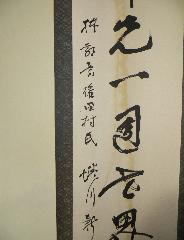
▲蜷川新の書「率先一周世界」に
「捧敬意権田村民・権田村民に敬意を捧ぐ・蜷川新」とある (東善寺蔵)
- Abe's book wrote: "I later received a polite thank-you letter from Dr. Ninagawa. He
wrote that he hated the ungrateful people of Gonda." (Page 188)
However, in contrast, Arata Ninagawa was asked by volunteers from Kurata
and Ubuchi villages* to write an inscription for the memorial erected by
Mizunuma River Bank in honor of Kozukenosuke Oguri, and he visited the
village before and after the war to thank the people of Gonda for the hard
work of escorting Mrs. Michiko to Aizu and for their activities to honor
Oguri, leaving the words "I offer my respect to the people of Gonda."
I would like to confirm this as well.
(Note*: Gonda Village merged with Sannokura Village to form Kurata Village
in 1889, which later merged with Ubuchi Village to form Kurabuchi Village
in 1955, which is now a part of Takasaki City since 2006.)
Arata Ninagawa made a hanging scroll with the following text.
"Dedicated to the people of the Gonda Village" (in the collection of Tozenji Temple)
阿部師は下記のように1939昭和14年に権田の東善寺を訪れている。
東善寺住職は
・「小栗上野介のことをくどくど尋ねた、はきはきしてくれない……老僧に向って『あんたは聾(つんぼ)かね』と大声で云うた。老婆はたまらぬげに『いや聾(つんぼ)ではない、昭和12年5月10日に裏山を越えた家からでた山火事でこの本堂と庫裏が焼けてから、少し気が遠くなったのです』と云ふ。私は急に悪かったと思った。」P318
(注:文中「聾」という差別語に類する表現がありますが、当時の文章のまま引用しました)
Abe visited Tozenji Temple in Gonda in 1939 (Showa 14).
Regarding the priest of Tozenji Temple, Abe wrote the following: "When I asked him about Kozukenosuke Oguri, he was very brisk and
did not speak ... Then I said in a loud voice, 'Are you deaf?' The old
woman beside him replied in an impatient tone, "No, he is not deaf,
but he has been lacking conentraiton since May 10, 1937, when a forest
fire broke out in a house at the back of the temple and destroyed the main
hall and the attic. I suddenly felt bad." (Page 318)
東善寺に参詣した阿部師に「聾かね」となじられたこの時の東善寺19世住職駒形痴道(こまがたちどう・東善寺19世住職)師は、私(村上泰賢)の師村上照賢の師匠(血縁ではない)である。駒形師は昭和10年に利根郡桃野村の常恩院から転住してきて2年後の1937昭和12年5月に東善寺が類焼火災に遭い本堂庫裡を全焼した。その2年後の1939昭和14年正月に仮本堂兼庫裡の小さな仮住まいで阿部師の訪問を受けている。
「本堂を一つ建てると、住職は寿命が10年縮む」といわれる。駒形痴道師は火災以来、病身を押して本堂の再建事業に取り組んでいたから、急な訪問を受けて小栗上野介に関する質問をされても、心ここにあらずで「気が遠かった」のだろう。
阿部師の訪問4年後の1943昭和18年9月に本堂の棟上げにこぎつけると、駒形住職はその上棟式の日の夕方に倒れ、「これでよかった…」といいながら翌日息を引き取ってしまった。知らせを受けて利根の常恩院から駆け付けた弟子村上照賢は葬儀を済ませると、住職をしていた利根郡桃野村(現みなかみ町)の常恩院を他の僧に譲って家族を連れ、東善寺に入って再建の事業を引き継いだ。戦中戦後の資金不足、かつ人手も建築資材も大工に出すお茶の葉さえ入手困難な状況の中で、再建事業に苦心した。
Chido Komagata, the 19th abbot of Tozenji Temple, who was scolded for being
deaf by Abe visiting Tozenji Temple, was the master of Shoken Murakami
(not by blood) who was the master of myself (Taiken Murakami). In May 1937,
two years after Komagata moved to Tozenji from a temple in Tone-gun, Gunma
Prefecture in 1935, Tozenji caught fire from a burning fire in the neighborhood
that destroyed the main temple building and its cloister. Two years later,
on New Year's Day in 1939 (Showa 14), Komagata was visited by Abe in his
small temporary residence in the temporary main hall and cloister.
It is said, "When one main hall is built for a temple, the priest's
life span is shortened by 10 years." Since the fire, Komagata had
been working on the reconstruction of the main building despite his illness,
so when he received a sudden visit and was asked questions about Kozukenosuke
Oguri, he was probably "distracted" from his work at heart.
In September 1943 (Showa 18), four years after Abe's visit, Komagata was
able to finish the building of the main hall, but on the evening of the
dedication ceremony, he collapsed and died the following day. His disciple
Shoken Murakami rushed to the temple upon receiving the news, and after
completing the funeral service, he handed over the temple in Tone county
where he had been abbot to another monk, took his family, and entered Tozenji
Temple to take over the rebuilding project. He struggled with the rebuilding
project under the circumstances of shortage of funds during and after the
war, as well as difficulties in obtaining manpower, building materials,
and even tea leaves for the carpenters.
・「駒形痴道は…小栗さんに対して村の人々の考え方が支離滅裂であることも語った」P319
「支離滅裂」がどういう内容か具体的でないが、いいイメージを与えない。「気が遠かった」駒形痴道師が果たしてこう語ったろうか。
村人の顕彰活動は小栗夫人の会津への脱出護衛から始まっている。明治以後もずっと供養顕彰を続け、権田村~倉田村~合併して倉渕村、の時代を通じても小栗上野介の顕彰活動を継続し、年忌供養の法要を欠かさず続けてきた。
駒形師が1935昭和10年に東善寺住職に着任した前後の顕彰活動でいえば、
・1932昭和7年、市川元吉元村長は建碑委員会を組織して水沼河原に顕彰慰霊碑を建立。
(昭和10年、大水害で流出―のちに発見―*駒形師はこの年東善寺住職として転住))
・昭和12年、顕彰慰霊碑を再建するにあたり、70年忌を実施、小栗上野介遺跡保存会(顕彰会の前身)を創立
・1937昭和12年5月、権田の市川亭三郎遺跡保存会長はNHK前橋放送局から「小栗上野介公を憶ふ」と題して業績を放送 (放送の数日前に東善寺は類焼失していた)
(昭和12年、東善寺焼失-1943昭和18年、本堂再建上棟式・終わって駒形は倒れ―翌日死去ー弟子の村上照賢が月夜野村・常恩院から東善寺へ転住)
・1945昭和20年、小栗上野介追悼座談会を開催
と東善寺の類焼失や戦中の困難な時代にも継続して実施していて、駒形が「支離滅裂」と語る状況はない。筆者が意図的に権田に対して悪いイメージを創出しているのを感じる。
"Chido Komagata... also said that the village people's thoughts about
Kozukenosuke Oguri were incoherent." (Page 319)
Although it is not clear what "incoherent" means here, it does
not give a good image about Gonda villagers. I doubt that Komagata, who
was "lacking concentration," would have said this kind of thing.
The villagers' activities in honor of Kozukenosuke Oguri began when they
escorted Mrs. Michiko Oguri and her family to Aizu. Even after the Meiji
period (1868-1912), the villagers continued to hold memorial services in
honor of Oguri, and they continued to do so on the anniversary of his death
without fail even during the period when Kurata Village was merged into
Kurabuchi Village.
Around the time when Komagata assumed the post of chief priest of Tozenji
temple in 1935, Gonda villagers continued to do the following activities
in honor of Kozukenosuke Oguri:
- In 1932 (Showa 7), Motokichi Ichikawa, the former mayor of the village,
organized a committee to erect a cenotaph on the banks of the Mizunuma
River and they erected it. (In 1935, the monument was washed away by a flood and was found. Chido
Komagata became the priest of Tozenji Temple in the same yaer.)
- In 1937 (Showa 12), when the cenotaph was rebuilt, the 70th anniversary
was held and the Kozukenosuke Oguri Ruins Preservation Society (the predecessor
of the Kozukenosuke Oguri Memorial Society) was founded.
- In May 1937 (Showa 12), Teizaburo Ichikawa, the chairman of the Kozukenosuke
Oguri Ruins Preservation Society, talked about the achievements of Kozukenosuke
Oguri in a radio program titled "Remembering Lord Kozukenosuke Oguri."
(Tozenji Temple had been destroyed by fire a few days before the broadcast.
In 1943 or Showa 18, Komagata collapsed after the framework completion
ceremony of the main building and died the next day.)
- In 1945 (Showa 20), a memorial symposium for Kozukenosuke Oguri was held
at Tozenji Temple.
After all, they continued the activities even after Tozenji temple was
destroyed by fire and during the difficult period of the war. Therefore,
there was no situation in which Komagata could say that "the people
of Gonda Village were incoherent." Now, I feel that Abe's words are
intentionally creating a bad image of Gonda villagers.
阿部師がやはり駒形痴道の言葉として
・「(東善寺が)永らく無住(住職不在)であった」P319
と書くが、東善寺住職は代々継続しているからそのような発言をするはずがない。これも
・「菩提所は大宮在の禅寺ださうで首もそこに埋めてあると云ふことですが…」p316 と、権田へのバスの中で、そのような虚構を知るはずもない地元の兵隊が語ったことにしているのと同工の、伝聞体の創作であろう。
阿部師はこうした根拠のない権田へのマイナスイメージ創出によって、「群馬・権田・東善寺へ行っても意味がない、埼玉・大宮・普門院へ来ればじゅうぶん」と、相対的に普門院へのイメージアップを狙ったのでしょう、と当地の古老はいう。
Master Abe wrote the following as the words of Chido Komagata:
"Tozenji Temple has been uninhabited for a long time." (Page
319)
In fact, Komagata could not have made such a statement, since Tozenji has
been continuously inhabited from generation to generation.
Abe also wrote that, on the bus ride to Gonda, a local soldier told him
the following:
"The family temple of Kozukenosuke Oguri is said to be a Zen temple in Omiya and his head is buried there..." (Page 316)
Since there is no way that a single soldier could have known such a thing,
all of these statements must be hearsay creations filled with fiction.
According to an old local resident, Abe was probably trying to say, "There
is no point in going to Tozenji Temple in Gonda, Gunma Prefecture and you
can just come to Fumon-in in Omiya, Saitama Prefecture," to improve
the relative image of Fumon-in, by creating such an unfounded negative
image of Gonda.
|
